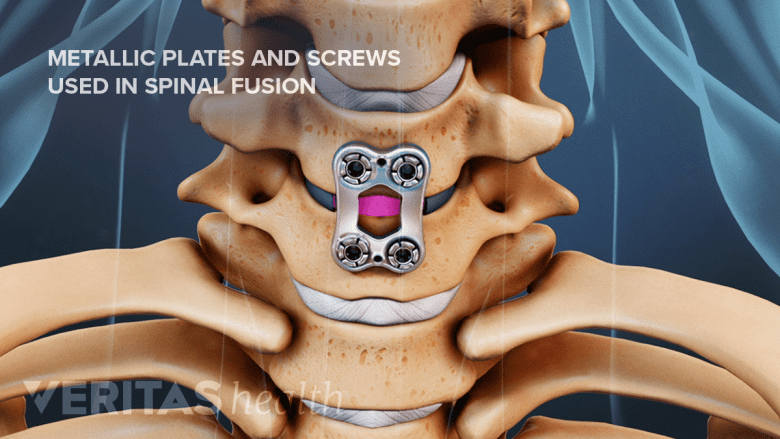Anterior cervical discectomy and fusion (ACDF) is a surgical procedure performed to alleviate neck pain and neurological symptoms by removing a damaged cervical disc and fusing adjacent vertebrae.
In This Article:
Steps in the Anterior Cervical Discectomy and Fusion (ACDF) Surgery Procedure

ACDF involves the removal of a damaged disc followed by fusion of the spinal segment.
The general procedure for an anterior cervical discectomy and fusion—or ACDF—surgery includes the following steps:
Anterior surgical approach
- The skin incision is one to two inches and is be made on the left or right hand side of the neck. The incision is usually made horizontally within a natural skin crease, though occasionally a more vertical incision is used for multilevel cases.
- The thin muscle under the skin is then split in line with the skin incision, and the plane between the sternocleidomastoid muscle and the strap muscles is then entered.
- Next, a plane between the trachea/esophagus and the carotid sheath is entered.
- A thin fascia (flat layers of fibrous tissue) covers the spine (pre-vertebral fascia), and is then dissected away from the disc space.
Disc removal
- Fluoroscopy provides an x-ray image of the spine during surgery, and is used to confirm that the spine surgeon is at the correct disc level of the spine.
- After the correct disc space has been identified, the disc is then removed by first cutting the outer annulus fibrosis (fibrous ring around the disc) and removing the nucleus pulposus (the soft inner core of the disc).
- With an anterior cervical discectomy, the entire disc is removed. The cartilage endplates on the vertebral bones are also removed to reveal the hard cortical bone underneath.
Cervical Spine Canal Decompression
- Dissection is carried out from the front to back of a ligament called the posterior longitudinal ligament, which lies between the disc and the spinal cord.
- Often this ligament is gently removed to allow access to the spinal canal to remove any disc material that may have extruded through the ligament, which may be contributing to cervical spinal stenosis.
- The uncinate processes—which are portions of the lower vertebral bone on either side that help form the boundaries of the disc—are typically at least partially removed as well. This is usually where osteophytes (bone spurs in the neck) need to be removed in order to relieve spinal cord or nerve root compression.
- The dissection is often performed using an operating microscope or magnifying loupes to aid with visualization of the smaller anatomic structures.
Cervical Fusion

Metal plates and screws stabilize the spine during the fusion process.
- An anterior cervical fusion is done following the cervical discectomy. The insertion of bone graft and possibly an implant or cage into the evacuated disc space serves to prevent disc space collapse and promote a growing together of the two vertebrae into a single unit, which is called "fusion". This helps to maintain the decompression by allowing adequate room for the nerve roots and spinal cord, and also to prevent local deformity (kyphosis).
- A small plate is often attached to the front of the spine with screws into each of the vertebral bones. This helps provide additional stability across the disc space, which promotes the healing “fusion” process.
- Once the cervical fusion occurs, bone is formed in the space where the disc used to be, uniting the vertebral bones above and below into one solid bone.
Patients typically go home the same day as the anterior cervical discectomy and fusion or after one night in the hospital.1Ban D, Liu Y, Cao T, Feng S. Safety of outpatient anterior cervical discectomy and fusion: a systematic review and meta-analysis. Eur J Med Res. 2016;21(1):34.
See Outpatient Anterior Cervical Discectomy and Fusion (ACDF)
Most patients recover within about 4 to 6 weeks, and some are able to return to most everyday activities after a few days or weeks. For the fusion to fully mature—meaning that it heals into one solid, strong bone—may take a full 12 to 18 months.
See Postoperative Care for Spinal Fusion Surgery
Patients should discuss relevant activity restrictions and rehabilitation with their surgeon, as they will vary depending on the individual's overall health, cervical spine condition, and the surgeon's experience.
- 1 Ban D, Liu Y, Cao T, Feng S. Safety of outpatient anterior cervical discectomy and fusion: a systematic review and meta-analysis. Eur J Med Res. 2016;21(1):34.

